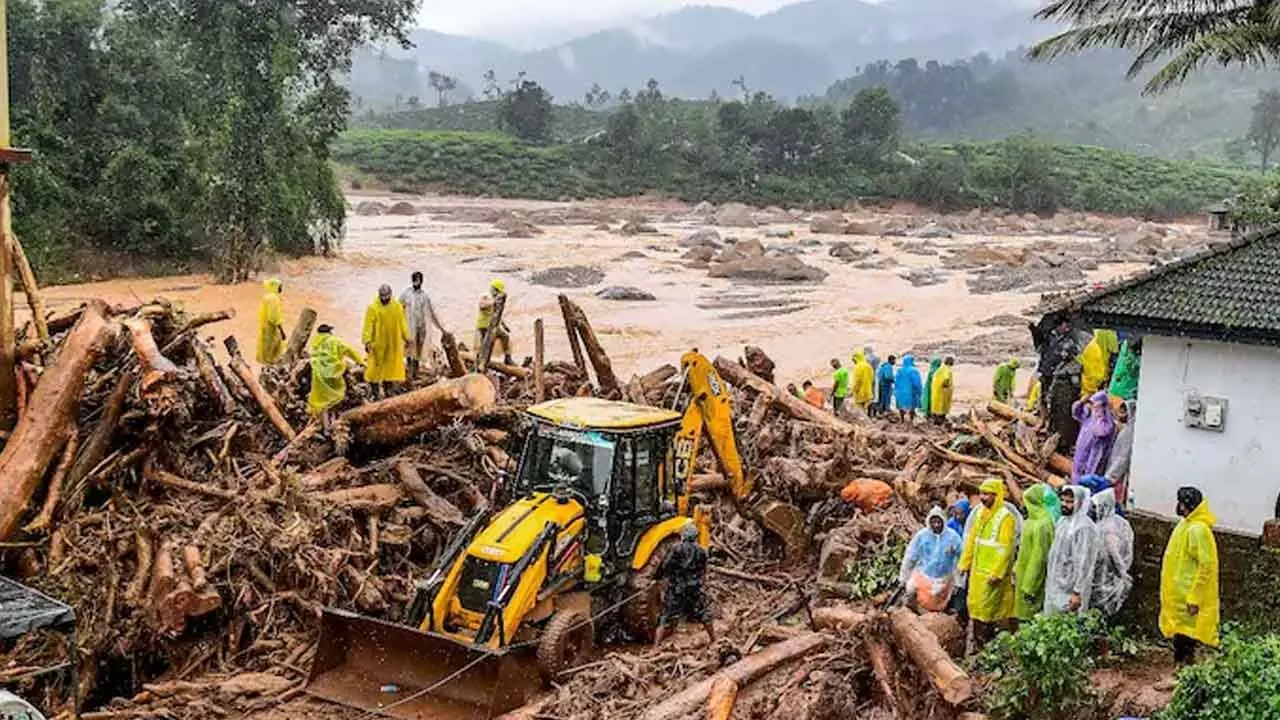Live
- They always want me to win, and now I feel lucky to have been offered a story like ‘Zebra’: Satyadev Kancharana
- ‘Democracy first, humanity first’: PM Modi in Guyana's parliament on two countries' similarities
- PKL Season 11: Telugu Titans register third straight win to top standings
- Is Pollution Contributing to Your COPD?
- NASA Unveils Underwater Robots for Exploring Jupiter's Moons
- Additional Central forces arrive in violence-hit Manipur
- AR Rahman and Saira Banu’s Divorce: Legal Insights into Common Issues in Bollywood Marriages
- 82.7 pc work completed in HPCL Rajasthan Refinery area: official
- Curfew relaxation extended in 5 Manipur districts on Friday
- Tab scam prompts Bengal govt to adopt caution over fund disbursement
Just In
Govts’ gross negligence, inaction costing lives


Around 80,000 landslides were said to have occurred in 10 states of Mizoram, Uttarakhand, Tripura, Arunachal Pradesh, J&K, Kerala, Manipur,...
Around 80,000 landslides were said to have occurred in 10 states of Mizoram, Uttarakhand, Tripura, Arunachal Pradesh, J&K, Kerala, Manipur, Maharashtra, Meghalaya and Assam during a four year period ended 2022, as per a study of ISRO in its Landslide Atlas of India. The Statement of Climate of India 2022 released by the India Meteorological Department lists casualties running into hundreds. This has failed to arouse any empathy or angst on the part of politicians and political parties, regional and national, to prod their governments to chart out a concerted action to combat growing threats to the country’s ecology. Driven by local interests, state governments continue to fail to pay heed.
As such, tragedies continue to happen. An area bustling with tourists, boosting livelihoods, has been laid a waste land by nature’s fury. Multiple landslides in a matter of hours hit the Mundakkai, a famous hilly tourist area in Wayanad district in what is termed as Kerala’s worst disaster. Massive swathes of slush and mud, buried dozens of people in their sleep early on Tuesday. Over 220 people were estimated to be killed and several are feared trapped in the ravaged region. The full magnitude of the disaster will be known in a few days. Already, more than 3,000 people were shifted to safety in temporary shelters.
The Wayanad tragedy may remind some of a similar but more massive landslide in Pithoragarh district in Uttarakhand. On 18 August 1998, an entire village, Malpa, was wiped away and buried and under debris in Kali Valley of the Himalayas. The rockfall that had started on 16 August built up movement and barreled down, smashing and burying everything in its way.
The trail of destruction in Mundakkai, Chooralmala, Attamala, and Noolpuzha, hampering search operations in Wayanad, is symptomatic of governments’ negligence of their duty to preserve fragile nature systems, especially in hilly regions. The world over, there has been a disturbingly steady rise in extreme weather events such as landslides, fires, floods and heatwaves. But the governments themselves turn naysayers and remain in abject denial, with the result that many areas turn into disaster hotspots. Among the natural disasters, landslides are most frequent.
The Government of India releases draft notifications on ecological sensitive areas (ESAs) which the States continue to ignore, holding that it would wreck livelihoods of thousands of people, dent local economies and affect footfalls of tourists from across the country as well as abroad. They are prone to blame landslides on extreme rains, and continue to carry on with ecology-disturbing activity like laying power lines or roads, allowing human habitations. This brazen short-sighted acts of the states is causing untold hardships to people and costing their lives, year after year. A panel had earlier warned Kerala government of around 18 places turning ecologically sensitive locations in Wayanad district. But, the government did little to prevent loss of lives. As such, it should come as no surprise that India figures among the top five landslide-prone countries in the world. The Himalayan region and the Western Ghats are considered most ecologically fragile. Eastern Ghats, too, where Araku region is located, sees landslide events. The ISRO study proves the necessity of a landslide inventory for the country with maps showing their locations and vulnerability. There is a need for regular studies of soil texture, lithology (general physical characteristics of rocks), geological faultlines, hill slopes, land use for development purposes in their vicinity etc. There is a need for a national system which issues landslide advisory, especially during heavy rainfall, and alerts governments to prevent loss of lives and property.

© 2024 Hyderabad Media House Limited/The Hans India. All rights reserved. Powered by hocalwire.com






